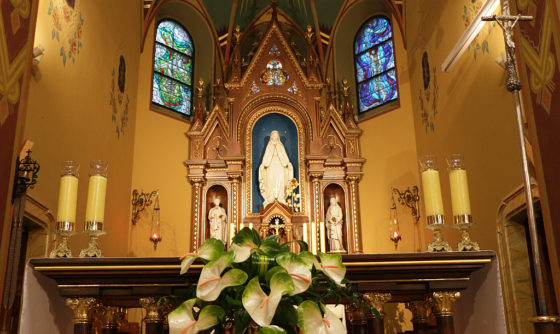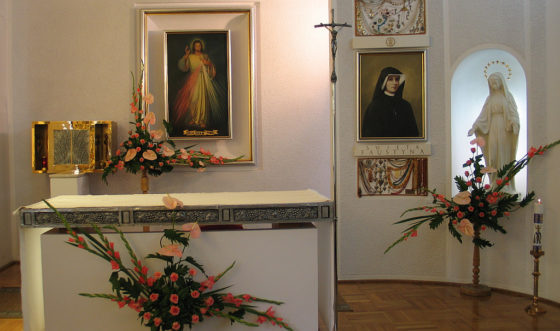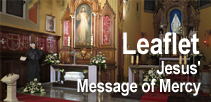Mary as “Our Lady of Mercy” has been venerated since the beginning of the Congregation of the Sisters of Our Lady of Mercy, which bears this title in its name. That this devotion deepened over the years was mainly due to St. Faustina’s own devotion, following revelations which she recorded in her “Diary”; and to the theology of the Mother of Mercy, which John Paul II stated in the encyclical “Dives in misericordia.” Echoes of and literal quotations from these works can be found in the (recent) Constitutions of 1985, in the Congregation’s prayer book, in the texts of its songs and in the experience of deeper personal devotion to Our Lady among modern generations of sisters. Mary is venerated in the Congregation first and foremost as the Immaculate Mother of the Son of God – Mercy Incarnate, who participated most fully in His saving work, so “Mary is the one who has the deepest knowledge of the mystery of God’s mercy. She knows its price, she knows how great it is.” (DM 9). She is also the mother of all people, to whom she shows mercy, leading them to the sources of the Saviour’s mercy. She is the most perfect model of Christian life and of all virtues, and the most effective means of obtaining graces from God, who is rich in mercy. Herself most fully endowed with grace, from generation to generation she proclaims the mercy of God and continually obtains mercy for the world.
Initially, Mary was venerated in the Congregation mainly as the one who is the Mother, the Protectress, the most perfect model of virtues, and a reliable support to the sisters in the pursuit of personal holiness, as well as in conducting fruitful apostolic work, or in imploring repentance for penitents. The spirituality of the Congregation could first and foremost be characterized by fervent zeal, which “holds each of its members in constant readiness to do and suffer everything to help repentant souls, entrusted to them by the Divine Master, return to the path of virtue” (Constitutions, 1909, p. 6). Sisters were to draw the spirit of the zeal from considering the great truths of the faith, especially the mystery of God’s mercy, and to ponder “the virtues and feelings of their Mother and Protectress, Our Lady of Mercy, whose patience, sweetness, and more than a mother’s compassion for sinners they will attempt to follow” (Constitutions, 1909, p. 6). The apostolate of mercy for girls and women in need of a deep moral renewal was carried out – as the Constitutions proclaimed – in the care of the Mother of Mercy, our hope, our help, our dearly beloved and most perfect model (Constitutions, 1909, p. 46).
The veneration of Our Lady of Mercy was expressed in the prayers, in the solemn celebration of feasts and, above all, in the imitation of her virtues so necessary in the pursuit of Christian perfection and apostolic work. The congregation’s rule laid down the prayers which the sisters were to say at designated times of the day. Among them were those commonly practised in the Church, such as the “Hail Mary”; the “Hours”; the “Rosary”; the “Litany of Loreto”; the “Magnificat”; the prayer that begins “We fly to your patronage”’; and the Maris Stella which begins “Hail, Star of the Sea”’; “the Chaplet to Our Lady of Perpetual Help”; the “Prayer for a Happy Death”; the “Guard of Honour Prayer to the Blessed Virgin”; the “Novena to the Immaculate Conception” as well as those prayers which specially appealed to the mercy of Mary. The latter were mainly: the “Chaplet to Our Lady of Mercy,” the antiphon prayer Salve Regina which begins “Hail, Holy Queen, Mother of Mercy” and the prayer of St. Bernard, the Memorare, beginning with the words: “Remember, O most gracious Virgin Mary…”. Already in their early morning prayer, the offering of the day, the sisters turned to God “through the Blessed Virgin Mary, Mother of Mercy, and St. Joseph.” (cf. Zbiór modlitw używanych w Zgromadzeniu Sióstr Matki Bożej Miłosierdzia [A Collection of Prayers used in the Congregation of the Sisters of Our Lady of Mercy], Krakow 1931).
Since the beginning of the Congregation the patronal feast has been celebrated on 5th August, because that day, the church venerated Mary, Mother of God. This date is associated with the dogma of the divine motherhood of Mary (Theotokos) and the anniversary of the dedication of the Basilica of St. Mary Major in Rome (Santa Maria Maggiore), the oldest church in the West dedicated to the Blessed Virgin. According to tradition, in 352 Mary appeared to Pope Liberius and to the Roman patrician John, ordering the building of the shrine in a place that she would show. On the night of 4th/5th August, during hot weather, snow fell on the Esquiline Hill, and a small shrine was built there, but such that in time it might have been destroyed. Pope Sixtus III, wishing to celebrate the end of the stormy Council of Ephesus (431), which proclaimed the dogma of the Divine Motherhood of Mary (Theotokos), decided to completely rebuild the shrine. The memorial of the dogma Theotokos was first celebrated in the basilica itself, but over time successive Popes expanded it first into Rome, and then to the whole Church. The memorial of Our Lady of the Snow is inscribed today in the liturgical calendar of the Church. It commemorates the miracle associated with the beginnings of the basilica, and the name is present in the consciousness of the faithful. The first celebration of the feast of Mary as Mother of the Son of God – the Source of all mercy has gone unrecorded. Therefore the same applies to the first occasion when special reverence was given, on that day, to Our Lady of Mercy in her Congregation in Poland.
On 5th of August 1937 at a congress in Warsaw, following the initiative of Superior General Michaela Moraczewska, the Mother Superiors decided that on 15th August sisters in all the monasteries elected Our Lady of Mercy as the heavenly superior general of the Congregation. On this day, Sister Faustina wrote that “Towards the end of the ceremony carried out in honour of the Mother of God, I saw the Virgin Mary, and she said to me, “«Oh, how your tribute of love has pleased Me.» And then She put all the sisters of our Congregation under Her cloak. She put Her right arm around Mother General Michaela, and Her left arm around me, and all the sisters were at Her feet, under the cover of Her cloak” (Diary 1244). Then, Our Lady gave this great promise through Sister Faustina: “Every one of you who perseveres in zeal until death in My Congregation shall evade the fire of Purgatory; and I want each of you to be characterised by the virtues of humility and meek[1]ness, chastity and love of God and neighbour, compassion and mercy” (Diary 1244). In an act of election, which is repeated in a supplemented version on 5th August each year, on the Feast of the Patron of the Congregation, the sisters once again entrust the helm of the Congregation into the hands of the Mother of Mercy, and entrust to her the spiritual and material development of the Congregation, all Sister Superiors, the sanctity of life of each sister as well as the persons entrusted to the apostolic care of the Congregation. Sisters promise their fidelity to Jesus, and that they will reflect in their lives His mercy towards all human misery; and that they will awaken confidence in God’s mercy throughout the world. They ask Mary to help them become the living sign of God’s mercy at work in the world, and place their hope in her maternal mercy, by which they wish to be supported forever, especially in times of suffering, in life’s adversities and at the hour of death. They say at the end “We venerate you Mother of Mercy – our most holy Mother General. Rule us, take care of us and lead us to God. Amen.”
The following factors contributed to the deepening of the devotion of Our Lady of Mercy in the Church and in the Congregation: the revelations of Saint Faustina, her unusual contact with the Mother of God handed over in notes left behind in her “Diary”, an increasing devotion to the Divine Mercy in the forms that Christ handed over through her, as well as the theology of the Mother of God undertaken again in the teaching of Pope John Paul II, and also including the theology of Mother of Mercy as shown in the encyclical “Dives in misericordia”. All these were reflected in the new Constitutions of 1985 and in the practice of devotion to Our Lady of Mercy.
Mary’s mercy is seen in close connection with the mystery of God’s mercy. Mary is above all the one who gave birth to the Son of God, Mercy Incarnate – as Sister Faustina simply writes (Diary 1745), and who participates in Christ’s work of salvation (Constitutions, Art. 3 and 8). She is also the one who “obtained mercy in a particular and exceptional way. (…) At the same time, still in an exceptional way, she made possible with the sacrifice of her heart her own sharing in the revealing of God’s mercy. (…) Mary, then, is the one who has the deepest knowledge of the mystery of God’s mercy. She knows its price, she knows how great it is. In this sense, we call her the Mother of Mercy: Our Lady of Mercy, or Mother of Divine Mercy” (DM 9) – as we read in the words of John Paul II in the 11th article of the Constitution. Mary became the Mother of Mercy in the most complete way at the foot of the Cross (Art. 39), where through Her Son’s obedience unto death the salvation of the world was fulfilled. Mary actively participated in this merciful plan of God the Father throughout her life, from the moment of the Incarnation to the offering of her only begotten Son which she made at Golgotha.
Finally, Mary is the Mother “of souls consecrated to God” (Art. 51), the most perfect model of holiness and the most effective means of help in imploring graces from God’s mercy. The Constitutions in many places speak of Mary as a model of docility to the Spirit, obedience to the will of the Father, chastity, poverty, trust, modesty … in a word – of mercy and holiness (cf. Art. 13, 17, 19, 24, 39, 51, and 247). The personal holiness of sisters, as stated in Article 321 of the Constitution, is carried out in the Congregation by following “the example of Mary, Mother of Mercy, and under her care”. Mary is not only ‘model’, but also ‘help’. In her the sisters are to find care, support and strengthen in every situation, especially in times of trouble and suffering, so that like her and together with her “they could put themselves at the disposal of God beloved above all, while seeking His will and His glory” (Art. 13). Through Mary, Mother of Mercy, sisters with a living faith “join in the life of Christ and His mission of salvation of the world” (Art. 3).
The devotion to Our Lady of Mercy is therefore expressed, firstly in the imitation of Mary, Mother of Mercy, and secondly by moulding of oneself to her virtues and in an attitude of trust in God and faithfulness in fulfilling His will as well as in self-sacrificing love for people. The devotion to Our Lady of Mercy is present in the Liturgy in its own votive Mass, which was approved for the Congregation by Cardinal Stefan Wyszynski on 3rd August 1974, as well as in a separate Feast, which is celebrated on 5th August, and preceded by a novena of prayers. By means of a document dated 17th February 2003, the Congregation for Divine Worship and the Discipline of the Sacraments approved a calendar specific to the Congregation of the Sisters of our Lady of Mercy, granting permission for the day (5th August) to be celebrated as a patronal feast in honour of Our Lady of Mercy. Other Marian feasts, present in the liturgical calendar of the Church, are also solemnly celebrated, and in addition – if liturgical rules allow for it – the Liturgy of the Hours of the Mother of God is recited every Saturday (Constitutions, Art. 264).
In fact, each day contains many prayers and references and to Our Lady of Mercy. Already in the morning offering of the day, the sisters turn to God, the Father of mercy, “through the Blessed Virgin Mary, whom You gave us for our patron as Mother of Mercy,” and ask her to pray for them. A prayer to Our Lady of Mercy is said every day after the breviary in the morning (“O Mary, Mother of Mercy,” and on Saturdays and Marian feasts: “Immaculate Mother of Mercy”) and the invocation “Mother of Mercy – pray for us”. At 9 am the sisters, together with Mary the Mother of Mercy call on the Holy Spirit and ask for graces for the development of the spiritual life of the Congregation, for the apostolic work and for new vocations. After the noon breviary, the sisters say a prayer that pleads for the salvation of the dying, referring to the painful agony of Jesus on the cross and the suffering of Mary, Mother of Mercy. At the time of the agony of Jesus (at 3 pm – The Hour of Mercy) the sisters stand in spirit at the foot of the cross, so that united with Mary they implore mercy for themselves and the whole world.
For many years “The Chaplet of Our Lady of Mercy” has been said, which commences with the antiphon “Hail, Holy Queen, Mother of Mercy.” In the petitions of the Chaplet those praying ask for defence against enemies of the soul, the presence of Mary at the time of death and that she intercede for all mercy with Her Son. In the final prayer the sisters express trust in Her motherly mercy (“You open wide Your arms for us and stretch out your hands full of all graces and gifts, Your heart wants to favour us with all we need …”). This mercy has the power to implore all that is needed, the power to keep souls in purity and innocence, and the power to nurture in them child-like love and to reflect in them the image of Jesus, who will lead all mankind to the ultimate purpose of human life – to the eternal light.
Each day in the Congregation ends with an Appeal to the Virgin Mary, during which the sisters pray for the Pope and for the Homeland saying “We fly to your patronage” and “Hail Mary” three times to express gratitude to the Mother of Mercy for the grace of vocation, and ask for zealous perseverance in their vocation until death. There are also other prayers to the Mother of Mercy in the prayer book of the Congregation, for example, the Memorare “Remember, O most gracious Virgin Mary…” of St. Bernard. With the consent of the ecclesiastical authorities, the petition “Mother of Mercy, pray for us” was added to the Litany of Loreto.
See also:
Devotion to the Virgin Mary in the life of St. Faustina in: Saint Faustina » Spirituality » Our Lady of Mercy
Prepared by: Sr. M. Elżbieta Siepak ISMM
Translated by Orest Pawlak

















